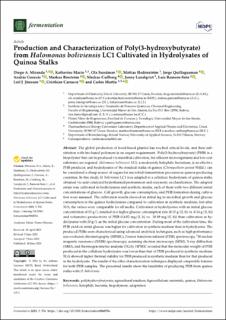| dc.contributor.author | Miranda, Diego A. | |
| dc.contributor.author | Marín, Katherine | |
| dc.contributor.author | Sundman, Ola | |
| dc.contributor.author | Hedenström, Mattias | |
| dc.contributor.author | Quillaguaman, Jorge | |
| dc.contributor.author | Gorzsás, András | |
| dc.contributor.author | Broström, Markus | |
| dc.contributor.author | Carlborg, Markus | |
| dc.contributor.author | Lundqvist, Jenny | |
| dc.contributor.author | Romero-Soto, Luis | |
| dc.contributor.author | Jönsson, Leif J. | |
| dc.contributor.author | Carrasco, Cristhian | |
| dc.contributor.author | Martín, Carlos | |
| dc.date.accessioned | 2024-02-01T17:13:22Z | |
| dc.date.available | 2024-02-01T17:13:22Z | |
| dc.date.created | 2023-08-30T08:37:54Z | |
| dc.date.issued | 2023 | |
| dc.identifier.citation | Fermentation. 2023, 9 (6), . | en_US |
| dc.identifier.issn | 2311-5637 | |
| dc.identifier.uri | https://hdl.handle.net/11250/3115139 | |
| dc.description.abstract | The global production of fossil-based plastics has reached critical levels, and their substitution with bio-based polymers is an urgent requirement. Poly(3-hydroxybutyrate) (PHB) is a biopolymer that can be produced via microbial cultivation, but efficient microorganisms and low-cost substrates are required. Halomonas boliviensis LC1, a moderately halophilic bacterium, is an effective PHB producer, and hydrolysates of the residual stalks of quinoa (Chenopodium quinoa Willd.) can be considered a cheap source of sugars for microbial fermentation processes in quinoa-producing countries. In this study, H. boliviensis LC1 was adapted to a cellulosic hydrolysate of quinoa stalks obtained via acid-catalyzed hydrothermal pretreatment and enzymatic saccharification. The adapted strain was cultivated in hydrolysates and synthetic media, each of them with two different initial concentrations of glucose. Cell growth, glucose consumption, and PHB formation during cultivation were assessed. The cultivation results showed an initial lag in microbial growth and glucose consumption in the quinoa hydrolysates compared to cultivation in synthetic medium, but after 33 h, the values were comparable for all media. Cultivation in hydrolysates with an initial glucose concentration of 15 g/L resulted in a higher glucose consumption rate (0.15 g/(L h) vs. 0.14 g/(L h)) and volumetric productivity of PHB (14.02 mg/(L h) vs. 10.89 mg/(L h)) than cultivation in hydrolysates with 20 g/L as the initial glucose concentration. During most of the cultivation time, the PHB yield on initial glucose was higher for cultivation in synthetic medium than in hydrolysates. The produced PHBs were characterized using advanced analytical techniques, such as high-performance size-exclusion chromatography (HPSEC), Fourier transform infrared (FTIR) spectroscopy, 1H nuclear magnetic resonance (NMR) spectroscopy, scanning electron microscopy (SEM), X-ray diffraction (XRD), and thermogravimetric analysis (TGA). HPSEC revealed that the molecular weight of PHB produced in the cellulosic hydrolysate was lower than that of PHB produced in synthetic medium. TGA showed higher thermal stability for PHB produced in synthetic medium than for that produced in the hydrolysate. The results of the other characterization techniques displayed comparable features for both PHB samples. The presented results show the feasibility of producing PHB from quinoa stalks with H. boliviensis. | en_US |
| dc.language.iso | eng | en_US |
| dc.rights | Navngivelse 4.0 Internasjonal | * |
| dc.rights.uri | http://creativecommons.org/licenses/by/4.0/deed.no | * |
| dc.subject | polyhydroxybutyrate | en_US |
| dc.subject | agricultural residues | en_US |
| dc.subject | lignocellulosic materials | en_US |
| dc.subject | quinoa | en_US |
| dc.subject | Halomonas boliviensis | en_US |
| dc.subject | halophilic bacteria | en_US |
| dc.subject | biopolymers | en_US |
| dc.subject | adaptation | en_US |
| dc.title | Production and Characterization of Poly(3-hydroxybutyrate) from Halomonas boliviensis LC1 Cultivated in Hydrolysates of Quinoa Stalks | en_US |
| dc.title.alternative | Production and Characterization of Poly(3-hydroxybutyrate) from Halomonas boliviensis LC1 Cultivated in Hydrolysates of Quinoa Stalks | en_US |
| dc.type | Peer reviewed | en_US |
| dc.type | Journal article | en_US |
| dc.description.version | publishedVersion | en_US |
| dc.rights.holder | © 2023 by the authors. | en_US |
| dc.subject.nsi | VDP::Teknologi: 500::Bioteknologi: 590 | en_US |
| dc.source.pagenumber | 0 | en_US |
| dc.source.volume | 9 | en_US |
| dc.source.journal | Fermentation | en_US |
| dc.source.issue | 6 | en_US |
| dc.identifier.doi | 10.3390/fermentation9060556 | |
| dc.identifier.cristin | 2170702 | |
| cristin.ispublished | true | |
| cristin.fulltext | original | |
| cristin.qualitycode | 1 | |

